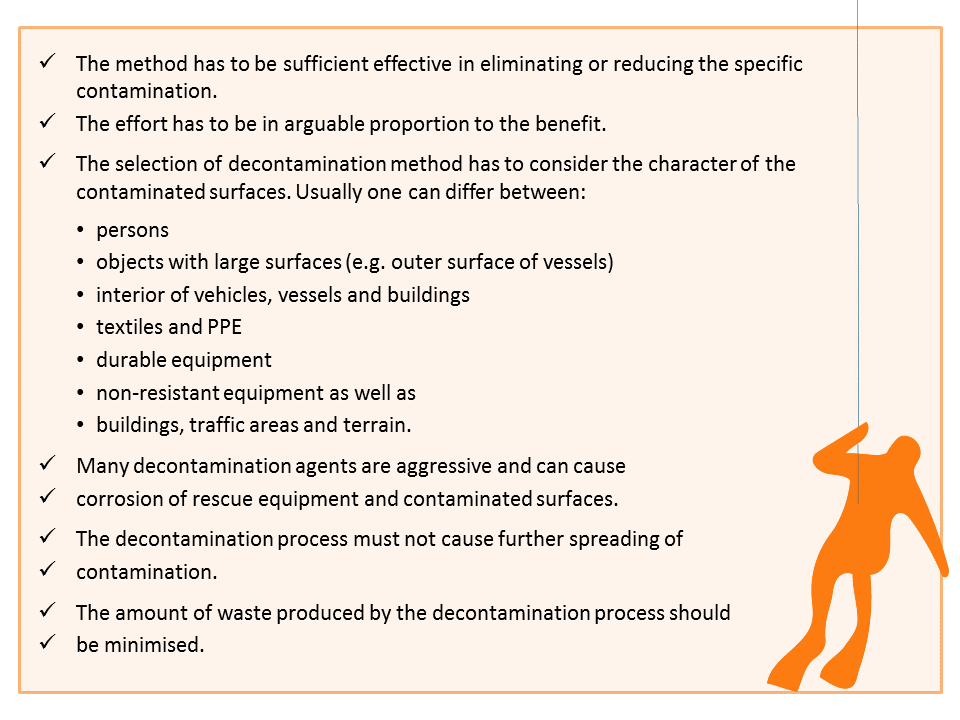Decontamination Methods and Agents, Selection of the Method


First concern
In general, any kind of clothing temporarily prevents the skin from contamination. Contaminated clothing itself increases the risk of contact with HNS. Therefore, the undressing of contaminated clothing is a crucial part of decontamination.
According to “Wallace rule of nines”, one can estimate the covered percentage of skin surface protected by clothing. For example, even during summertime about 50 % of body surface is covered by clothing, and thus can be decontaminated by simply removing the upper clothing.

When rescue personnel wears full body personal protective equipment (PPE), 100 % of body surface is covered and protected against direct contamination. Therefore, correct and thorough undressing of the PPE removes all of the contamination from the person. As a conclusion, in most cases undressing is the most important decontamination method.
In technical terms, the decontamination itself is performed either by removal or annihilation of the contaminant by wet, dry or spot decontamination.
As far as possible, one should check the effectiveness of decontamination by appropriate measurements.
Decontamination Methods
| REMOVAL | Removing of the contaminant by physical methods like washing, evaporation, suctioning, sweeping or swapping. E.g. use of solvents, water, surfactants, detergents, soaps or special decontamination foams. |
| ANNIHILATION | Inactivation of biological agents by disinfectants; oxidising of chemical agents by strong oxidisers. Attention: disinfectants and oxidisers are hazardous agents as well. |
| WET DECONTAMINATION | Use of fluids like surfactants or disinfectants to clean the surfaces. Attention: After appliance the decontamination agent needs some reaction time before it can be removed. |
| DRY DECONTAMINATION | Cleaning of surfaces by suctioning, swapping, sweeping or adhesive materials. |
| SPOT DECONTAMINATION | Quick coarse cleaning of single skin parts (e.g. face, crook of the arm, wounds) to remove intensive point contamination. |
Decontamination Agents
Depending on the HNS present, the following cleaning agents can be applicable:
| contaminant | cleaning agent |
|---|---|
| radioactive particles | water + neutral detergent, water + chelating agent |
| known biological or infectious agents | applicable disinfectant |
| unknown biological agents | peracetic acid |
| blood and other body fluids | alcohol-based disinfectants, peracetic acid |
| benzene, aromatic hydrocarbons | polyethylene glycol 400 |
| fuel, mineral oils | liquid soaps, washing-up liquid, sorbents, cleaning rags |
| fats; high viscous, non-water soluble compounds | degreaser (solute in water), soap, soft soap, washing-up liquid, firefighting foam |
| lyes | water |
| acids | water, 25 % sodium carbonate solution |
| chemical warfare agents | bleaching powder, alcoholic lye, bleaching lye |
One has to check the tolerance of the surfaces prior to appliance.
Selection of Decontamination Method
Before choosing the applicable decontamination method one should consider the following criteria:
Finally, the selection of the decontamination method depends on the available time and available equipment. Furthermore one has to verify whether the decontamination should be executed actively or contaminated objects could be left untreated to environmental conditions which can remove or reduce the contamination (passive decontamination).
What Can Happen if You Choose a Wrong Decontamination Method?
Beside further spreading of contamination, the most crucial consequence of a wrong decontamination method can be a vigorous reaction between the decontamination agent and the contaminant.
For example, these reactions can lead to the formation of an explosive atmosphere explosion, toxic gases: Chlorine / nitrous fumes, or intense heat and fire: neutralization / oxidizing.
